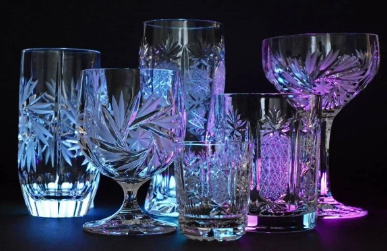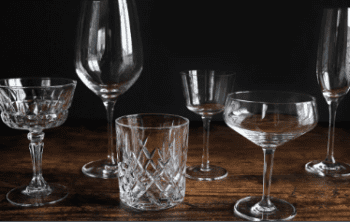Lead glass, also known as lead crystal or flint glass, is a type of glass that contains a significant amount of lead oxide in its composition. This unique blend of materials gives lead glass its distinctive brilliance, clarity, and shimmering appearance, making it a cherished material for creating exquisite glassware and decorative items. Throughout history, lead glass has been prized for its optical properties and has been used to craft fine glassware, chandeliers, jewelry, and luxury items.

Composition and Characteristics:
Lead glass is primarily composed of silica (sand), soda ash (sodium carbonate), potash (potassium carbonate), and lead oxide. The presence of lead oxide, typically ranging from 10% to 30% or more, significantly alters the glass’s optical and physical properties. The lead content imparts a higher refractive index and dispersion to the glass, giving it an exceptional sparkle and brilliance that sets it apart from regular glass.
Optical Brilliance and Refraction:
The higher refractive index of lead glass means that light passes through it at a slower speed and bends more than in regular glass. This bending of light, known as refraction, is responsible for the captivating sparkle and rainbow-like prismatic effect seen in lead glass items. The refraction also contributes to the glass’s ability to disperse light, creating flashes of color and enhancing its overall visual appeal.
Clarity and Transparency:
Lead glass is renowned for its unmatched clarity and transparency. Its high refractive index and low iron oxide content ensure that it remains nearly colorless, allowing light to pass through with minimal absorption or distortion. This property makes lead glass perfect for creating clear glassware, stemware, and decorative objects.
History and Artistic Significance:
The origins of lead glass can be traced back to the 17th century in England, where the addition of lead oxide to glass was discovered by George Ravenscroft. His innovation resulted in the creation of high-quality glassware with improved brilliance, and the material became known as lead crystal. The secret to making lead glass was guarded closely, and its production quickly spread across Europe, becoming a symbol of luxury and refinement.
Applications:
Lead glass has been used for a wide range of applications due to its exceptional beauty and optical properties. Some of its prominent uses include:
- Glassware and Stemware: Lead glass is a popular choice for crafting fine glassware, including wine glasses, decanters, and crystal tumblers. Its sparkle and clarity add elegance to dining experiences and formal occasions.
- Chandeliers and Lighting: The refractive and dispersion properties of lead glass make it a perfect material for creating dazzling chandeliers and lighting fixtures, spreading light in a mesmerizing manner.
- Jewelry: In jewelry making, lead glass is used to create simulated gemstones, also known as rhinestones or crystals. The brilliance and sparkle of these glass gems closely mimic the appearance of genuine gemstones, adding a touch of glamour to various accessories.
- Art and Decorative Items: Lead glass is used to craft decorative items, figurines, and art pieces. Its ability to capture and play with light makes it a favorite medium for artisans to create stunning sculptures and decorative objects.
Health Considerations:
While lead glass is prized for its beauty, it’s important to note that it may present some health concerns due to the lead content. The lead in the glass can potentially leach into liquids or foods, especially if the glassware is improperly stored, damaged, or used to store acidic or alcoholic beverages. As a result, some health experts recommend limiting the use of lead glassware for decorative purposes rather than for food or beverage consumption.
Conclusion:
Lead glass, with its captivating brilliance and historical significance, has left an indelible mark on the world of art, design, and craftsmanship. Its unique optical properties continue to inspire artisans, designers, and glass enthusiasts alike. While its lead content raises health concerns, lead glass remains an iconic and cherished material that reflects centuries of artistic and cultural significance. As we appreciate the beauty of lead glass, it is also essential to consider its historical context and use it thoughtfully in our modern lifestyles.


